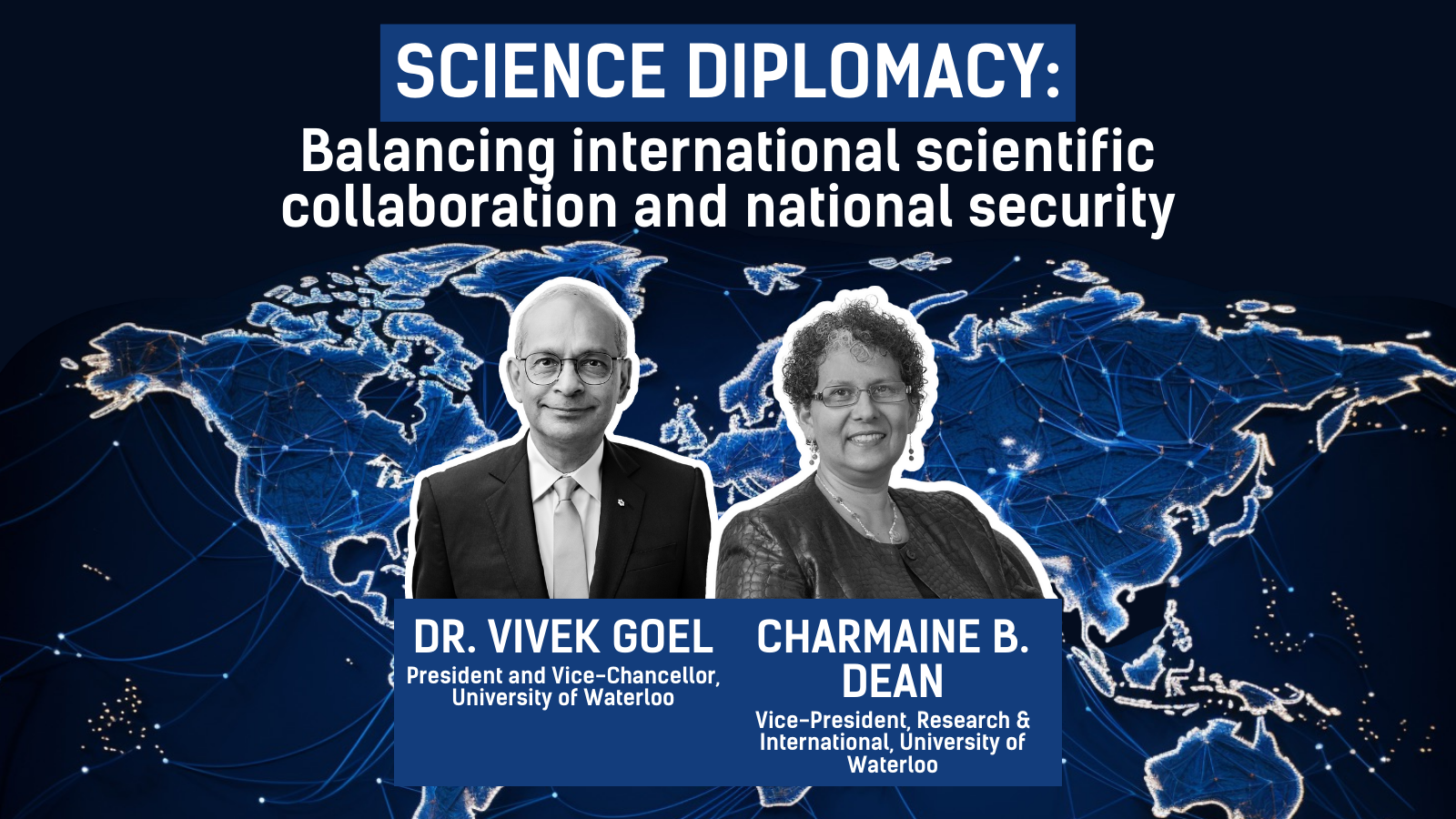Science diplomacy: Balancing international scientific collaboration and national security

Author(s):
Dr. Vivek Goel
University of Waterloo
President and Vice-Chancellor
Charmaine B. Dean
University of Waterloo
Vice-President, Research & International
Disclaimer: The French version of this editorial has been auto-translated and has not been approved by the author.
2023 is on track to become the hottest year on record with unprecedented forest fires, flooding and tropical storms around the planet. The world is still facing the consequences of the global COVID-19 pandemic. The cost-of-living crisis is growing more and more severe. There is biodiversity loss and substantial global risk of ecosystem collapse.
Complex global challenges cannot be tackled by siloed efforts. We know we need a united front and high-level international scientific cooperation; we need to reach out beyond our fields of study, our institutions, and our countries to embrace the collective pursuit of knowledge.
We need to embrace scientific collaboration on the international stage to address global challenges.
However, we also face armed conflicts in many parts of the world and increasing tensions between many countries. Tensions are increasing between Canada and countries with which we had been building relations. We must certainly all work to protect the best interests of Canada. How do we continue to pursue scientific collaborations that will help address global challenges while protecting our national interests? There are so many widespread challenges that require us coming together as a global community to tackle, bringing creativity and diversity of solutions to the table to help us navigate forward.
An important answer is science diplomacy. Our international research relationships need to fall under this framework.
Science diplomacy offers a country-agnostic, non-political path forward on shared goals. It can provide the expertise needed to underpin a bi-national treaty on clean water, support the work of global disease monitoring or facilitate international student exchanges. When space agencies come together for complex multi-national projects, their respective governments draw up the necessary legal agreements. And when diplomatic ties are under pressure, joint research efforts keep dialogue open.
International scientific collaboration is a driver of science diplomacy.
In 1976, a report by the United States National Academy of Sciences began to solidify scientific consensus that ozone layer depletion was primarily driven by chlorine-containing source gases – primarily CFCs and related halocarbons. Consequently, a few countries, Canada included, eliminated the use of CFCs in aerosol containers. However, it would take further science-informed political wrangling and a very successful public education campaign focused on easy-to-understand concepts and plain language to turn the tide on global policy.
In 1987, the United Nations’ Montreal Protocol on Substances that Deplete the Ozone Layer was ratified. As a result of this remarkable intervention and the global cooperation required for success, the ozone layer is now projected to recover by the middle of this century. Without this international treaty in place, ozone depletion would have increased tenfold by 2050 with far-reaching and disastrous consequences.
This is an example of science diplomacy.
In a climate of rising geopolitical tensions, we must find a way forward with science diplomacy. Following the Second World War with the rise of multi-lateral institutions, governments actively encouraged universities and other institutions to form partnerships with countries across the globe. Binding together economies and cultures was viewed not only as an opportunity for learning and exchange but also as a bulwark against international conflict.
The recent extension of the joint US and China science and technology agreement is a good example of forging ahead despite significant headwinds. The agreement, first signed in 1979, was considered a turning point in diplomatic relations between the two nations. While the agreement will need to be renegotiated in six months and its future remains precarious, the signing of the extension is itself a gesture of goodwill. The European Union is keeping a close eye on what happens next as it navigates a similar balance on pursuing areas of mutual interest with China while pausing more sensitive endeavors.
Engagement with dynamic and ambitious countries is essential if we are to address global challenges. It’s abundantly clear that the Canadian science and technology sector has benefitted immeasurably from this kind of exchange. To be left out of international collaborations is to be left behind, particularly with respect to innovation. We need to strike the right balance between safeguarding sensitive areas of Canadian research and intellectual property and working with the international community in areas of mutual concern. Solving humanity’s most pressing challenges – from preventing the next pandemic to tackling the climate crisis – will require nimble science diplomacy and universities need to continue to build bridges when and where possible.
Some of the best science is done in collaboration with others, whether it is with colleagues across the hall or on the other side of the world. Sharing diverse perspectives helps to unlock new insights and drive innovation. Only through these exchanges will we continue to build a more robust and resilient world.

